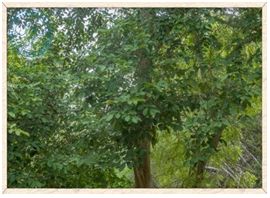
Botanical Name – Holoptelea integrifolia
Common Name – Indian elm , kanju Chirivilva
Classification
Kingdom – Planatae
Class – Magnoliopsida
Order – Rosales
Family – Ulmaceae
Genus – Holoptelea
Species – integrifolia
General Characteristics of Family Ulmaceae
The Ulmaceae consist of monoecious or hermaphroditic trees, often with mucilage canals. The leaves are simple, with secondary veins terminating in teeth (except Ampelocera), usually spiral and usually becoming distichous, stipulate, serrate, often basally oblique. The inflorescence is axillary, of solitary flowers or a cyme or panicle. The flowers are small, unisexual or bisexual, actinomorphic. The perianth is of 5 [2–9], spiral tepals, apotepalous or basally connate. The stamens are typically numerous. Anthers are dorsifixed-versatile. The pollen is 4–7-porate. The gynoecium is syncarpous, with a superior ovary, 2–3 carpels and locules. The styles are 2–3. Placentation is apical-pendulous; ovules are anatropous to amphitropous, bitegmic, 1 per locule. The fruit is dry, often a samara
Plant Description
Habit : The Indian elm is a large deciduous tree, about 20–25 m tall (rarely over 30 m), with a broad crown featuring several ascending branches.
Status : Least concern
Stem : Bark is grey in colour, covered with blisters, peeling in corky scales on old trees.
Leaves : Leaves are alternately arranged, elliptic-ovate in shape, 8–13 cm long and 3–6.5 cm wide, smooth, with entire margins (occasionally toothed), and a pointed tip. Leaf base is rounded or heart-shaped. Stipules are lance-shaped. Crushed leaves emit an unpleasant odour.
Flowers : Flowers are small, greenish-yellow to brownish, pubescent, borne in short racemes or fascicles at the scars of fallen leaves. Sepals are velvety, often 4.
Fruit : Fruit is a circular samara, 2.5 cm in diameter, with membranous, net-veined wings, and flat seed.
Pollination : Pollination and seed dispersal were accomplished via wind.
Medicinal Uses
The bark and leaves are employed in the treatment of oedema, diabetes, leprosy and other skin ailments, digestive disorders, piles, and sprue. They are utilised topically to cure boils, swellings, and rheumatic pain.
Minerals, phenolic compounds (flavonoids), carbohydrates, proteins, amino acids, and saponins can all be found in this plant.
Traditionally, the medicines derived from this tree have been used to cure inflammation, piles, menstrual problems, and biliousness.